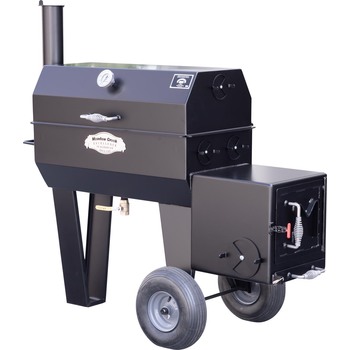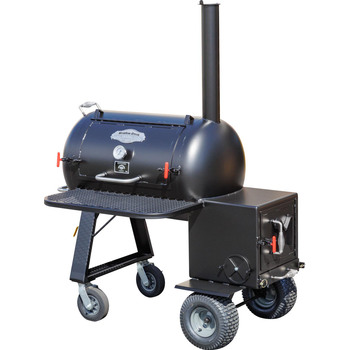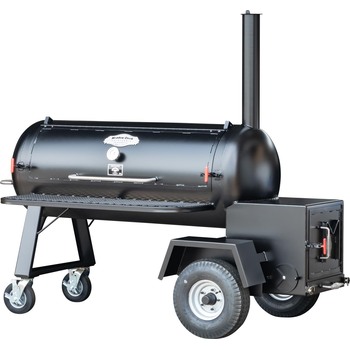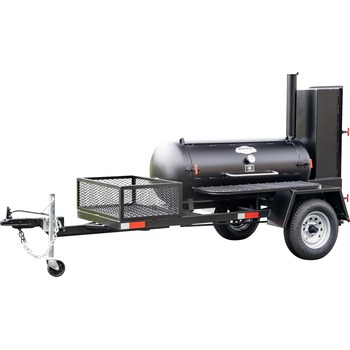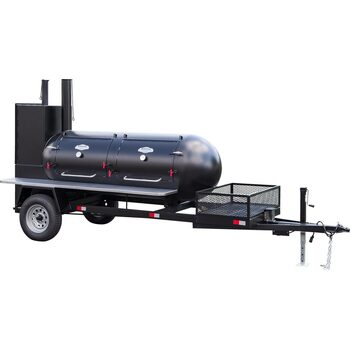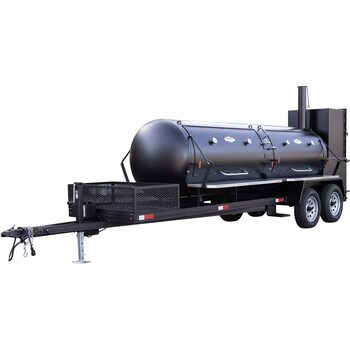Handmade Offset Smokers For Sale
Available from small to gigantic, offset smokers are your everyday workhorse for any kind of indirect cooking. Meadow Creek’s offset smokers earn rave reviews for the exquisite smoke flavor they produce, for their even temperatures across the cook chamber, and for the way the temps can be dialed in and locked in the chosen range during a long cook.
New to Offset Smokers?
If you’ve never used an offset smoker before, these smokers offer an experience that you can’t get using an automated smoker. As a rule, you have to add more wood or charcoal every 45–60 minutes. Some people shy away from them because of that, but in reality it adds to the fun outdoor cooking experience.
"I cooked 4 pork butts, 8 racks of St. Louis style ribs, and a case of whole chicken legs. They turned out the best I've ever made, no exaggeration! These cookers make a seasoned professional out of an amateur."
—Jim, JD's Smoky Pit BBQ
"The TS250 and BBQ42 chicken cooker make cooking so easy, it’s nearly set it and forget it. It cooks like a dream with the tastiest chicken anywhere."
—Mark Stalvey, Gaffney, SC, Cherokee Pit
Offset Smokers in Action
Grilling and Smoking a Variety of Foods
Featuring a TS250 Tank Smoker equipped with optional upgrades.
Cooking for Hundreds
Featuring a TS250 Tank Smoker equipped with optional upgrades.
Ribs, Sausage, and Chicken
Featuring a TS250 Tank Smoker equipped with optional upgrades.
Need Help Choosing an Offset Smoker?
Contact a Meadow Creek dealer for a quote and advice in choosing the model and upgrades that are right for you.
Made With Integrity
We believe it takes more than raw steel and cool machines to build a grill or smoker. That's why every piece of equipment is handmade in a culture of integrity.
Why You Should Consider a Meadow Creek Offset Smoker...
A common problem with cheap offset smokers is inconsistent temperature—it can be a real battle maintaining the fire for long cooks. Our charcoal/wood-fired smokers make it a breeze to crank out amazing barbecue and give you the fun of playing with fire.
- If you like managing a live fire, they are fun to use—even on longer cooks.
- You can deck out one of our reverse flow smokers with lots of cool options, including insulated firebox, stainless steel workshelves, and a mounted chicken cooker. What's more, we promise to make it exactly how you ordered it.
- We put our whole heart into producing top quality. You really need to see the workmanship in real life to fully appreciate it, but everything from the heavy steel doors to the positive-lock latches to the smooth welds, sliding stainless steel grates, and rounded tank ends designed for optimal airflow comes from a passion to give you the best value for your dollar.
- The trailer models look great behind your pickup truck or SUV and come with a 2" ball hitch, a heavy-duty wheel jack, rubber torsion axles, and flush-mount LED lights.
Usage Summary: If you want to cook with indirect heat, but occasionally cold smoke cheese and cook over direct heat choose a Meadow Creek offset smoker with an optional charcoal grill pan.
Difference in Models: Available in charcoal/wood fired models. The TS120, TS250, and TS500 models each come built on a highway trailer. The other models are made to move around by hand. Sizes range from smaller backyard models to the 500-gallon TS500. Browse the product listings above for photos, features, measurements, and add-ons for each model.
Need Help Choosing?
The Meadow Creek Buyer Guide will help you define your goals and choose an offset smoker or grill with confidence.
A Guide to Offset Smokers
Barbecue culture is deeply rooted in history, traditions, and the culinary passions of individuals across the globe. For enthusiasts, the quest to achieve the perfect smoky flavor, tender texture, and mouthwatering aroma has led to the development of various barbecue techniques and equipment. One such piece of culinary magic is the offset smoker—a widely loved approach that combines art and science to craft exceptional barbecued dishes. In this comprehensive guide, we delve into the world of offset smokers, exploring their design, functionality, cooking techniques, and tips to elevate your barbecue game.
The Evolution of Offset Smokers: From Past to Present
Offset smokers, also known as barrel smokers or stick burners, have a rich history dating back to the early days of barbecue. Their evolution mirrors the development of barbecue itself – a fusion of ingenuity, culinary prowess, and a love for authentic flavors. These smokers have come a long way from their humble beginnings, evolving into sophisticated machines that can turn a novice into a pitmaster.
Originally crafted from repurposed barrels and other metal components, early offset smokers were simple in design. The heat source, typically a wood fire, was located in a separate chamber (the firebox), while the main cooking chamber housed the meat. Smoke and heat would flow from the firebox into the cooking chamber, enveloping the meat in a tantalizing embrace of flavor.
Modern offset smokers have retained the essence of this design, but with notable enhancements in construction, insulation, and precision. The market now offers a wide range of options, from traditional stick burners to high-end models boasting temperature control systems and innovative features.
Anatomy of an Offset Smoker: Understanding the Components
To truly appreciate the magic of an offset smoker, one must grasp the intricacies of their construction. A typical offset smoker consists of several essential components:
- Firebox: This is where the fuel, usually wood or charcoal, is burned. It's responsible for generating the heat and smoke that will flavor the meat.
- Cooking Chamber: The primary space where the meat is placed for cooking. It's designed to receive indirect heat and smoke from the firebox.
- Smokestack: Positioned at the opposite end of the cooking chamber, the smokestack serves as an outlet for smoke and excess heat. Proper positioning and size are crucial for maintaining an ideal airflow.
- Dampers: These control the airflow in the smoker, regulating temperature and smoke levels. A combination of dampers on the firebox and smokestack allows for precise heat management.
- Grates: These provide the surface on which the meat is placed for cooking. High-quality, well-maintained grates ensure even cooking and attractive grill marks.
- Thermometers: These smokers often have built-in thermometers to monitor the cooking chamber's temperature. For accuracy, it's recommended to use additional meat probes.
Cooking Techniques: Mastering the Art of Offset Smoking
Achieving barbecue perfection with an offset smoker requires more than just equipment; it demands an understanding of cooking techniques, patience, and a passion for the craft.
- Fire Management: The heart of offset smoking lies in fire management. Consistency is key; maintain a steady fire in the firebox, using a combination of wood logs and charcoal. Avoid overloading the firebox, as it can lead to excessive heat and bitter smoke.
- Indirect Heat Cooking: The essence of offset smoking is cooking with indirect heat. Place the meat on the cooking grates in the chamber farthest from the firebox, ensuring that it's exposed to smoke and heat without direct flames.
- Smoke Infusion: The offset smoker's specialty is its ability to infuse the meat with rich, smoky flavors. Select hardwoods like oak, hickory, or fruit woods, and place them on the burning coals for a consistent and aromatic smoke.
- Temperature Regulation: Achieving and maintaining the right cooking temperature is essential. Adjust the dampers on the firebox and smokestack to control airflow and thus temperature. Invest in reliable temperature probes to monitor both the cooking chamber and the meat.
- The Texas Crutch: For larger cuts like brisket and pork shoulder, consider using the "Texas crutch." Wrap the meat in aluminum foil partway through the cooking process to accelerate tenderness. However, this may reduce the intensity of the smoky bark.
Choosing the Right Offset Smoker: Factors to Consider
Investing in an offset smoker is a commitment, so making the right choice is crucial. Several factors should influence your decision:
- Size and Capacity: Determine the quantity of food you'll typically cook. Smaller smokers are ideal for personal use, while larger models suit gatherings or events.
- Material Quality: Look for sturdy materials like thick steel, which aids heat retention and durability.
- Construction: Opt for welded seams over riveted ones, as they minimize heat leakage. Gaskets around doors and dampers help maintain a tight seal.
- Airflow Control: Easily adjustable dampers allow precise control over temperature and smoke levels.
- Budget: An offset smoker can vary widely in price. While higher-end models offer more features, there are excellent budget-friendly options too.
Tips and Tricks for Offset Smoking Success
- Pre-season Your Smoker: Before your first cook, season your smoker by coating the interior with cooking oil and running a low-temperature fire for a few hours. This minimizes the chances of metallic flavors affecting your food.
- Start Small: Begin with smaller cuts like chicken or ribs before tackling larger meats like brisket. This helps you understand your smoker's nuances without risking a major cook.
- Maintain Cleanliness: Regularly clean your smoker's cooking grates, interior, and firebox. Grease buildup can lead to inconsistent heat and undesirable flavors.
- Experiment with Wood: Different wood varieties impart unique flavors. Experiment with combinations to find your signature smoky profile.
- Patience is Key: Offset smoking is a slow and steady process. Embrace the waiting game, as the results are well worth it.
Offset smokers hold a special place in the hearts of barbecue aficionados for their ability to transform raw ingredients into mouthwatering masterpieces. With their history steeped in tradition and their design perfected over time, these smokers offer a journey into the world of authentic barbecue. By understanding their anatomy, mastering cooking techniques, and selecting the right equipment, you can unlock the secrets of offset smoking and create unforgettable culinary experiences that will linger in the memories of those fortunate enough to savor your creations. So, fire up your offset smoker, embrace the art of slow cooking, and embark on a flavorful adventure that connects you to the essence of barbecue like never before.
Unlocking the Magic: The Allure of Offset Smokers in the World of BBQ
In the world of barbecue, smoking isn't just a cooking method; it's a way of life. Enthusiasts spend countless hours perfecting their craft, experimenting with different woods, rubs, and techniques to create the ultimate smoky flavors. Among the arsenal of smoking devices, one stands out as a true icon: the offset smoker. This article delves into the captivating reasons why people around the world adore offset smokers over other types of smokers, and why these machines have become synonymous with authentic barbecue experiences.
1. The Art of Traditionally Crafted Flavors
Offset smokers, often referred to as "stick burners," have earned their place as the epitome of traditional barbecue. These smokers carry the torch of time-honored techniques, harkening back to the origins of smoking meats. For aficionados, using an offset smoker is like stepping into the shoes of pitmasters from bygone eras, embracing the time-tested ritual of tending to a wood fire and allowing its aromatic embrace to envelop the meat.
While other smokers may offer convenience through technology, offset smokers stand as a testament to the romance of the barbecue journey. The act of adding wood logs to the firebox, adjusting dampers, and feeling the heat's ebb and flow becomes a sensory experience that connects pitmasters to the very essence of barbecue history.
2. The Dance of Temperature Mastery
Barbecue isn't just about cooking food; it's a delicate dance of temperature control. Offset smokers embody this dance in its purest form, demanding a level of skill and attention that goes beyond simply pushing buttons. Pitmasters must finesse the fire, adjust dampers, and anticipate the smoker's response to external factors like wind and weather.
This nuanced approach to temperature control is a source of pride for offset smoker enthusiasts. The mastery of fire management becomes a badge of honor, separating the true pitmasters from the casual grillers. The reward for this dedication is the unmatched flavor profile that results from the perfect harmony of wood, heat, and time.
3. The Artistry of Bark and Smoke Ring
Offset smokers are renowned for their ability to create the holy grail of barbecue aesthetics: the coveted bark and smoke ring. The bark, a crispy and flavorful outer layer on smoked meats, forms as a result of the Maillard reaction and the slow cooking process. The smoke ring, a pinkish-red layer just beneath the surface, develops through the interaction of smoke and myoglobin in the meat.
Offset smokers excel at producing these barbecue hallmarks due to their consistent exposure to smoke and indirect heat. The real wood fire infuses the meat with rich flavors and that telltale pink ring, creating visual and gustatory delights that are simply irresistible.
4. Community and Connection
The allure of offset smokers extends beyond the flavors they produce; it's about fostering a sense of community and connection. From backyard gatherings to competitive cook-offs, offset smokers are often at the heart of social experiences. The act of tending to the smoker, sharing stories around its warm glow, and ultimately savoring the fruits of labor brings people together in a way that transcends the mere act of eating.
Passing down barbecue traditions, sharing tips, and engaging in friendly debates about wood choices and rub recipes create bonds that go beyond the realm of food. Wood-fired smokers serve as catalysts for forging friendships, making memories, and uniting people over a shared love for barbecue culture.
5. Customization and Craftsmanship
Offset smokers, often handcrafted by skilled artisans, carry a sense of individuality and craftsmanship. While other smokers might come off an assembly line, these smokers can be tailored to suit a pitmaster's unique preferences. From the design and dimensions to the choice of materials and finishes, each offset smoker can be a work of art in its own right.
This customization isn't just about aesthetics; it also affects performance. Pitmasters can tweak airflow dynamics, add tuning plates, or modify baffle systems to achieve the perfect cooking environment. This level of control and personalization allows for a deeper connection between the pitmaster and the smoker.
6. The Meditative Journey of Slow Smoking
In a world that often celebrates speed and instant gratification, a manual wood smoker invites us to slow down and savor the process. The extended cooking times inherent to offset smoking provide an opportunity to disconnect from the hustle and bustle of daily life and embrace a more leisurely pace. The act of waiting, tending the fire, and watching the transformation of raw meat into succulent barbecue is a form of meditation.
The anticipation that builds during those long hours creates a sense of gratification that's incomparable. When the moment finally arrives to slice into the perfectly smoked brisket or tender ribs, it's a culmination of patience, dedication, and a deep appreciation for the art of offset smoking.
In a world where modern technology often dictates the pace of culinary innovation, handmade wood-fired smokers stand as a timeless reminder of the beauty and magic that come from embracing tradition and passion. The allure of offset smokers goes beyond the sumptuous flavors they create; it's about the journey, the camaraderie, and the genuine connection to the heart of barbecue culture. As the fire crackles, the wood smolders, and the meat slowly transforms into a masterpiece, offset smokers invite us to step into the shoes of pitmasters from eras past, embarking on a journey where the path is as rewarding as the destination itself.
Beyond Brisket: Exploring the Diverse World of Foods to Smoke on an Offset Smoker
When it comes to offset smokers, the allure of perfectly smoked brisket often takes center stage. However, the culinary canvas of these smokers extends far beyond this iconic cut of meat. From succulent poultry to flavorful vegetables and even unconventional ingredients, offset smokers offer an expansive playground for experimenting with a variety of foods. In this exploration, we'll dive into the diverse world of meats and foods that can be beautifully transformed through the magic of offset smoking.
1. Brisket: The King of Smoked Meats
Let's begin with the undeniable star of offset smoking – brisket. This beef cut, known for its rich marbling and tender texture, becomes a masterpiece when slowly cooked in an offset smoker. The extended cooking time allows the fat to render, infusing the meat with smoky flavors and creating a beautiful crust known as "bark." Whether you prefer a classic Central Texas-style rub or something more inventive, brisket is the cornerstone of many memorable barbecue feasts.
2. Ribs: From Baby Back to St. Louis
Ribs are a quintessential smoked delicacy, and offset smokers offer the perfect platform to achieve that sought-after tenderness and irresistible smokiness. From baby back ribs with their delicate meat to St. Louis-style ribs with a bit more meaty bite, the offset smoker's indirect heat and real wood smoke work their magic, resulting in juicy, flavorful ribs that practically fall off the bone.
3. Chicken: Smoky and Succulent
Smoking chicken on an offset smoker transforms this versatile protein into something extraordinary. Whole chickens, chicken quarters, or even individual cuts like wings and drumsticks benefit from the slow, indirect heat. The natural fats in the skin baste the meat as they render, resulting in juicy, tender chicken with a smoky flavor that's hard to beat.
4. Pork Shoulder: The Art of Pulled Pork
Pork shoulder, also known as pork butt, is a prime candidate for offset smoking. Low and slow cooking breaks down the tough connective tissues, resulting in succulent, pull-apart meat that's perfect for sandwiches, tacos, or simply enjoying on its own. The offset smoker's consistent heat and smoke infusion create a symphony of flavors that elevate the humble pork shoulder to barbecue royalty.
5. Seafood: An Ocean of Smoky Possibilities
Offset smokers aren't limited to meats; they also lend their smoky charm to seafood. Salmon, trout, and other fatty fish become sublime when gently smoked. The offset smoker's gentle heat prevents overcooking and allows the fish to absorb the wood's flavors without compromising its delicate texture.
6. Sausages: Savor the Smoke
Sausages of all kinds – from classic bratwurst to spicy chorizo – benefit from a turn on the offset smoker. The slow cooking process allows the flavors of the sausages to meld with the smoky aromas, resulting in mouthwatering bites that are bursting with taste.
7. Vegetables: Elevating Plant-Based Delights
Offset smokers aren't limited to meats alone; they can also transform vegetables into delectable delights. Eggplant, peppers, and even corn take on a new dimension when smoked, adding depth and complexity to your vegetarian offerings.
8. Cheese: Elevating Dairy to New Heights
Yes, even cheese can be cold smoked on an offset smoker! A smoking tube with smoking pellets prevents melting while infusing the cheese with subtle smokiness. Harder cheeses like cheddar, gouda, and provolone take particularly well to smoking.
9. Fruits: Sweet and Smoky
The interplay of smoke and sweetness creates a tantalizing contrast when offset smokers are used to smoke fruits like peaches, apples, and pears. The smoky notes elevate the natural sugars, resulting in unique flavor profiles that can be used in both sweet and savory dishes.
10. Desserts: Ending with a Smoky Sweet Note
Why stop at savory dishes? Offset smokers can be used to add smoky dimensions to desserts. Consider cooking pecan pie, cast iron skillet cookies, apple crisps, peach cobbler, and many other desserts to take them to a new level.
The world of offset smoking extends far beyond the confines of brisket, offering an expansive range of culinary possibilities. From meats that melt in your mouth to unexpected delights like smoked cheese and fruits, the offset smoker's ability to infuse foods with rich smoky flavors knows no bounds. Whether you're a traditionalist who revels in the classics or an adventurous culinary explorer eager to push boundaries, the offset smoker invites you on a flavor-packed journey that's as diverse as it is delicious. So fire up your offset smoker, explore the vast array of foods at your fingertips, and savor the irresistible magic of smoke-infused cuisine.
A Comprehensive Guide to Choosing Wood for Your Offset Smoker
The art of offset smoking transcends mere cooking; it's a symphony of flavors conducted by the wood you choose. Selecting the right wood is paramount to infusing your meats and foods with the perfect smoky essence. This guide will walk you through the intricate process of choosing wood for your offset smoker, ensuring that your culinary creations are nothing short of exceptional.
1. Understand Flavor Profiles
Different woods impart distinct flavors to your smoked foods. Consider these flavor profiles as you make your choice:
Fruitwoods (Apple, Cherry, Peach): Mild and slightly sweet, fruitwoods are perfect for delicate meats like poultry and fish. They provide a subtle, nuanced flavor that enhances without overpowering.
Hickory: A classic choice for a robust smoky taste, hickory pairs well with beef, pork, and game meats. It's a staple in Southern barbecue, delivering a hearty and bold flavor.
Oak: Offering a balanced smokiness, oak is versatile and complements a wide range of meats. It's popular in Central Texas barbecue and provides a clean, neutral base that lets the meat's natural flavors shine.
Mesquite: Bold and intense, mesquite is ideal for hearty meats like beef and lamb. It has a distinctive earthy aroma and is often used in Southwestern and Tex-Mex cuisine.
Pecan: Offering a milder version of hickory's richness, pecan wood lends a slightly sweet and nutty flavor. It's a great choice for poultry, pork, and even game meats.
Maple: Delicate and subtle, maple wood adds a light smokiness with a hint of sweetness. It's well-suited for poultry, vegetables, and cheeses.
2. Consider Ingredients and Pairing
Think about the ingredients you're smoking and how the wood's flavor will interact with them. Lighter meats, like chicken and fish, benefit from milder woods to avoid overpowering the delicate flavors. Denser meats, such as pork and beef, can handle stronger woods that can complement and enhance their taste.
3. Regional Traditions
Embrace regional barbecue traditions when choosing your wood. Different styles of barbecue have their preferred woods. If you're aiming for a specific regional taste, research the traditional woods used in that style.
4. Aromatic Woods
Don't overlook aromatic woods like cedar, alder, and maple for seafood. These woods contribute enticing fragrances that elevate the overall experience, adding a layer of complexity to your smoked fish.
5. Wood Quality and Preparation
Ensure you're using high-quality, well-seasoned wood. Avoid wood that's been treated with chemicals, paint, or varnish, as these can produce undesirable flavors. The wood should be dry to prevent the formation of creosote and resin on your meats.
6. Experiment and Adapt
Each pitmaster has their unique preference for smokiness intensity. Start with a moderate amount of wood and adjust as you go. It's advisable to conduct small batch tests to understand how different woods affect your dishes.
7. Mixing Woods
Don't be afraid to mix woods to create your own signature flavor profile. Combining mild and strong woods can result in a harmonious balance that enhances your culinary creations.
8. Let the Meat Shine
Remember, the wood's role is to enhance, not overshadow, the natural flavors of your meats and foods. The goal is to create a symphony of taste where the wood complements the main ingredient.
In the world of offset smoking, the wood you choose is the conductor of a flavorful orchestra. With this guide in hand, you're equipped to make informed decisions that will elevate your offset smoking endeavors to new heights. Whether you're crafting the perfect brisket, delicately smoking seafood, or experimenting with unique combinations, the right wood will be your partner in creating unforgettable culinary experiences.

